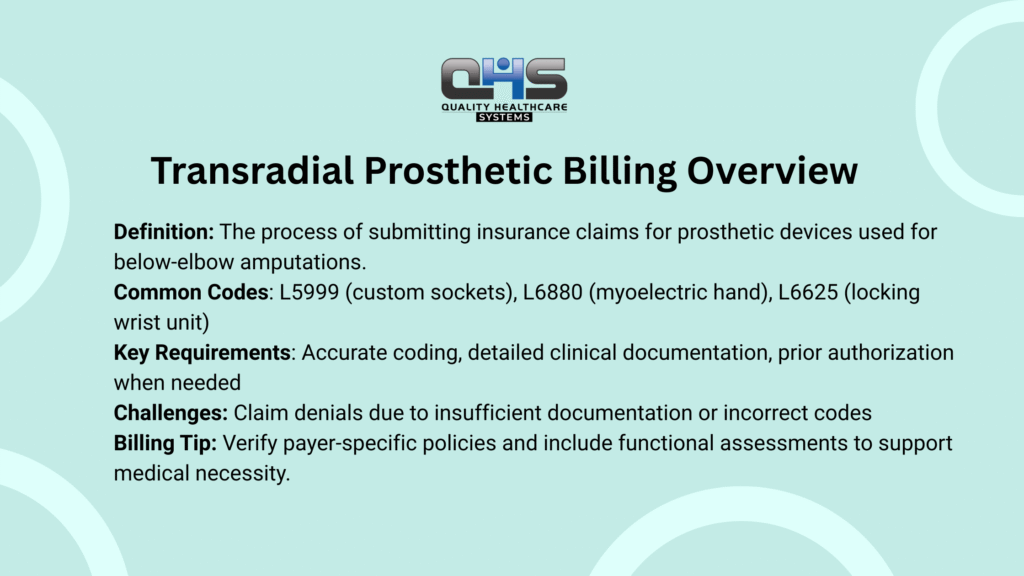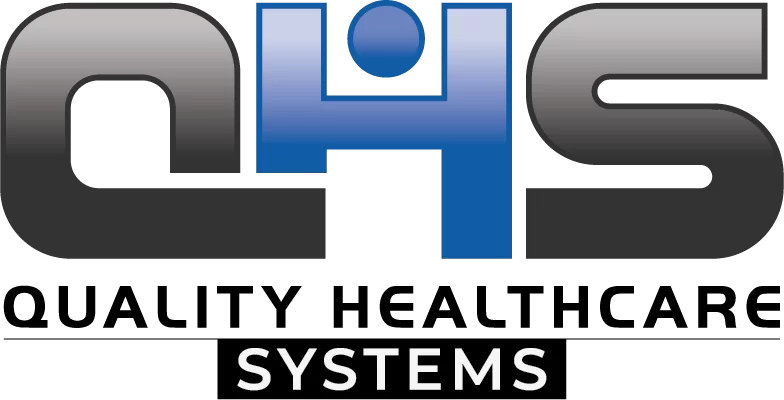If you’re responsible for billing transradial (below-elbow) prosthetics, you know the process goes far beyond choosing the right HCPCS codes. It requires a deep understanding of how upper-limb function affects coverage, how to align physician documentation with payer expectations, and when to initiate prior authorizations to avoid reimbursement issues.
In this guide, we’ll walk you through the entire billing journey for transradial prosthetic devices—from identifying the correct diagnosis codes to securing clean reimbursements—so you can streamline approvals, meet compliance standards, and minimize costly claim rework.
What Is a Transradial (Below-Elbow) Prosthesis and When Is It Prescribed?
A transradial prosthesis replaces an arm below the elbow, restoring function lost due to amputation or congenital absence. It’s prescribed when the residual limb has sufficient length and condition to support a prosthetic device, enabling the user to perform daily activities and improve independence.
What Is Transradial Prosthetic Billing?
Transradial prosthetic billing involves submitting medical claims for prosthetic devices fitted below the elbow. It requires accurate coding, documentation of medical necessity, and compliance with payer guidelines to ensure reimbursement for components like sockets, hands, and control units used in transradial prostheses.
How Do You Bill Medicare for a Transradial Prosthesis?
Transradial prosthetic billing to Medicare requires strict compliance with billing protocols, itemized claims, and thorough documentation to ensure reimbursement. Medicare Part B covers transradial prostheses under the Durable Medical Equipment, Prosthetics, Orthotics, and Supplies (DMEPOS) benefit, but only when all requirements for medical necessity and coding accuracy are met.

What Steps Are Essential in Transradial Prosthetic Billing for Medicare?
To properly handle transradial prosthetic billing, verify that the prosthesis is covered under Medicare Part B’s DMEPOS benefit. Once confirmed, billing must use appropriate L-codes to itemize each component:
-
L6880 — Myoelectric prosthetic hand
-
L6625 — Locking wrist unit
-
Other relevant L-codes depending on the prosthesis components
Itemizing components separately helps Medicare evaluate the claim accurately and prevents partial denials.
What Modifiers Should Be Used in Medicare Billing for Transradial Prosthetics?
Modifiers clarify details about the billed item, improving claim accuracy:
-
RT or LT — Specify right or left side for the transradial prosthesis
-
NU — Denotes new equipment, which affects reimbursement rates and documentation requirements
Applying these modifiers correctly is critical to avoid Medicare claim rejections or payment delays.
Related Posts:
- Medical Billing for Hemipelvectomy Prosthetic
- Medical Billing for Spinal Orthoses
- Prosthetic Billing for Lower Limbs
- Medical Billing for Transtibial Prosthetic
What Supporting Documents Are Required for Medicare Transradial Prosthetic Billing?
Submissions must include all necessary documentation to validate the claim:
-
Certificate of Medical Necessity (CMN), when applicable, especially for powered devices or custom-fabricated components
-
Clinical documentation that supports the medical necessity, including physician notes and prosthetist evaluations
-
Manufacturer invoices or detailed pricing information for unlisted or custom codes to justify the charges
Providing comprehensive documentation minimizes the risk of audits and claim denials.
What Are the Key HCPCS Codes Used for Transradial Prosthetic Billing?
Billing for a transradial prosthesis requires using specific HCPCS Level II codes that reflect the socket type, terminal device, wrist unit, and control system. Errors in code selection commonly lead to denials or audit triggers.
| Code | Description | Billing Notes / Use Case |
|---|---|---|
| L5301 | Below elbow, molded socket, external power, self-suspending | Base code for myoelectric below-elbow prosthesis |
| L5500 | Wrist disarticulation socket, molded to patient model | Use for wrist-level amputation prosthesis |
| L5620 | Addition to upper extremity, test (diagnostic) socket | Billable for initial fitting phase |
| L5631 | Addition to upper limb, below-elbow socket, molded laminated socket | Custom definitive socket after test fitting |
| L6611 | Addition, upper limb, wrist disarticulation with flexible inner socket | For added comfort and suspension in wrist prostheses |
| L6621 | Upper limb addition, wrist, flexion unit | Allows wrist flexion/extension; usually paired with terminal device |
| L6624 | Wrist unit, friction, adjustable | Standard wrist for mechanical devices |
| L6625 | Wrist unit, locking, adjustable | For patients needing secure positioning of terminal device |
| L6629 | Quick disconnect wrist | For easy device interchangeability |
| L6880 | Myoelectric prosthetic hand | Common code for powered hand component |
| L6881 | Battery, lithium-ion, for use with prosthetic limb | Often billed in pairs with L6880 |
| L6882 | Charger for lithium-ion battery, external power | Needed for powering the prosthesis |
| L6935 | Terminal device, passive, cosmetic glove | Often used when billing for aesthetic-only prosthesis |
| L6965 | Terminal device, mechanical hand, voluntary opening | Common in mechanical setups; manual open-close action |
| L6975 | Terminal device, mechanical hook, voluntary closing | Offers more precise control; typically for work environments |
| L7405 | Addition, upper limb, harness, single control | Harness setup for cable-operated devices |
| L7499 | Upper extremity prosthesis, not otherwise specified | Requires invoice and supporting documentation |
| L8465 | Battery case | For housing batteries in powered systems |
| L8470 | Battery, alkaline, per cell | Low-cost but less commonly reimbursed vs. lithium-ion |
| L8480 | Charger, external, for battery-powered prosthesis | Ensure match with battery type when billing |
| L5999 | Unlisted lower extremity prosthetic component | Use only when no other code fits; must include invoice and justification |
Best Practices for Transradial Prosthetics Billing
Accurate coding using the correct HCPCS L-codes is essential to prevent claim denials and delays. Maintain thorough clinical documentation, including physician prescriptions, detailed prosthetist evaluations, and functional assessments. Always verify payer-specific prior authorization requirements before submission.
Use modifiers properly (e.g., RT/LT, NU) and ensure all supporting documents, such as CMNs and manufacturer invoices, are complete and up-to-date. Regularly review payer policies and audit claims internally to catch errors early. Timely submission and consistent follow-up on outstanding claims improve cash flow and reduce rework.
Common Reasons for Transradial Prosthetics Claim Denials and How to Avoid Them
Claims are often denied due to missing or incomplete prior authorization, incorrect or mismatched L-codes, and insufficient documentation of medical necessity. Errors in laterality modifiers (RT/LT) and failure to submit required supporting paperwork like CMNs also contribute to denials.
To avoid this, verify all documentation before submission, ensure authorization approvals are secured when required, and cross-check codes with payer fee schedules. Maintain clear communication with payers to clarify policies and promptly address any claim rejections with complete appeal documentation.
How Do You Determine the Functional Level for Transradial Prosthetics?
Upper limb functional levels are not formally categorized like K-levels in lower limb prosthetics, but clinical documentation must still clearly establish the patient’s functional status and daily goals. This directly affects insurance approval, especially when prescribing advanced prosthetic components such as myoelectric hands or powered wrists.
What Functional Activities Should Be Documented?
Determining functional level for upper limb prosthetics begins with a clear description of the patient’s ability to perform both Activities of Daily Living (ADLs) and Instrumental Activities of Daily Living (IADLs). This includes:
Basic ADLs
-
Eating using utensils with or without adaptive aids
-
Grooming tasks such as brushing teeth or combing hair
-
Dressing independently, including tasks like buttoning shirts or tying shoelaces
Instrumental ADLs (IADLs)
-
Completing job-related tasks that involve both hands
-
Managing household responsibilities such as cooking or childcare
-
Driving or commuting using adapted vehicles or steering aids
This information provides context for why a particular prosthetic design or technology is required and what functional independence it aims to restore.
What Assessment Tools Are Used to Evaluate Upper Limb Function?
To reinforce the necessity of a prosthetic device, clinicians often rely on standardized assessment tools. Two commonly used tools include:
Assessment of Capacity for Myoelectric Control (ACMC)
This assessment evaluates a patient’s ability to use a myoelectric prosthesis effectively in real-world tasks. It measures how well the individual controls powered components and the reliability of their performance, which is essential for justifying coverage of HCPCS codes like L6880 (myoelectric hand) or L6881 (powered wrist).
Canadian Occupational Performance Measure (COPM)
The COPM focuses on patient-identified performance goals. It allows individuals to report perceived challenges in daily tasks and rate their satisfaction with performance levels. This tool is particularly useful for demonstrating that the prescribed prosthesis aligns with meaningful functional improvements.
Who Should Provide Documentation for Functional Level?
While physician documentation is necessary, the most robust functional level assessments come from occupational therapists and prosthetists. Supporting notes should include:
-
A summary of tasks the patient cannot perform without the prosthesis
-
A clinical explanation of how the device will restore or improve function
-
Descriptions of specific environments (workplace, home, community) where function is impacted
-
Justification for advanced components based on observed or projected functional gains
Clear, collaborative documentation improves the defensibility of claims and increases the likelihood of prior authorization approval, especially for high-cost prosthetic systems.
When Is Prior Authorization Required for a Transradial Prosthesis?
Prior authorization (PA) is a critical step in the billing process for transradial prosthetics, especially when advanced or custom components are involved. While Medicare does not mandate PA upfront, it conducts stringent post-payment reviews, making thorough documentation essential. Most commercial insurers and Medicaid plans require PA before approving claims to ensure medical necessity and cost-effectiveness.
For Which Components Is Prior Authorization Typically Required?
Prior authorization is commonly required for the following prosthetic components and services:
-
Myoelectric devices: This includes powered hands and wrists coded as L6880 (myoelectric hand) and L6881 (powered wrist). These devices are higher cost and require justification of functional benefit.
-
Custom-fabricated sockets: Codes such as L5999 cover custom sockets tailored to the patient’s residual limb, which often need pre-approval due to complexity and expense.
-
Pediatric prosthetics and specialized accessories: Pediatric fittings or high-cost add-ons, including advanced suspension systems or control mechanisms, generally require PA to confirm necessity.
Understanding payer-specific policies on these items helps avoid claim denials and delays.
What Documentation Is Required to Support Prior Authorization?
Comprehensive and well-organized documentation significantly increases the chances of PA approval. Key documents include:
-
Physician’s signed prescription explicitly stating the amputation level and medical necessity of the prosthesis.
-
Clinical notes detailing the patient’s residual limb condition, health status, and rationale for the specific prosthetic choice.
-
Prosthetist’s evaluation report summarizing measurements, fitting challenges, and justification for custom or advanced components.
-
Functional assessment records demonstrating limitations in activities of daily living (ADLs) and the anticipated improvement with the prosthesis.
This evidence collectively supports the clinical need and functional benefit required by payers.
What Are Best Practices for Managing Prior Authorization?
It is highly recommended to:
-
Contact the payer directly before submitting the request to verify current PA criteria, required forms, and documentation standards.
-
Confirm estimated turnaround times for approval decisions to plan patient care and billing workflows effectively.
-
Maintain clear communication with all involved clinicians to ensure all necessary documentation is submitted promptly.
What Clinical Documentation is Required to Support a Transradial Prosthetic Claim?
Thorough clinical documentation determines whether your claim will get paid. Payers want objective medical evidence, functional justification, and clearly linked prosthetic components to functional outcomes.
Detailed Content:
- Physician’s chart notes (not just Rx)
- Confirm amputation level
- Mention residual limb condition, skin integrity, ROM
- State purpose of prosthesis
- Prosthetist’s evaluation
- Functional capacity
- Justification for each component: terminal device, wrist, harness
- Anticipated benefit to patient
- Therapist evaluations or vocational rehab assessments (for advanced tech)
- Templates should align with MACRA/MIPS compliance where applicable.
Why Is Attention to Detail Critical in Transradial Prosthetic Billing for Medicare?
Because Medicare enforces strict guidelines and fee schedules on transradial prosthetic billing, accurate coding, thorough documentation, and proper use of modifiers are non-negotiable. Advanced components or unusual cases may require appeal-level documentation to secure payment, emphasizing the need for detailed records and follow-up.
How Do You Handle Claim Denials for Transradial Prosthetic Devices?
If your claim for a transradial prosthesis is denied, focus on documentation gaps and payer-specific policy mismatches. A well-structured appeal letter with clear evidence often reverses denials.
Detailed Content:
- Common denial reasons:
- Lack of physician documentation
- Missing functional justification
- Upcoded or mismatched L-codes
- Include in appeal:
- Clinical notes
- Prosthetist evaluation
- Manufacturer invoice for unlisted codes
- Use payer appeal templates and track deadlines strictly.
- Mention relevant LCD/NCDs (e.g., DME MAC Upper Limb Prosthesis Policy Article, if applicable).
Required Documentation Checklist for Transradial Prosthetic Billing to Medicare
To ensure smooth processing and approval of Medicare claims for transradial prostheses, include the following essential documents with every submission:
1. Physician’s Prescription (Signed)
-
Must specify the amputation level (transradial/below elbow)
-
Clearly state the medical necessity for the prosthesis and components
-
Include justification for advanced or myoelectric devices if applicable
2. Certificate of Medical Necessity (CMN)
-
Required especially for powered prosthetic devices and custom-fabricated components
-
Completed and signed by the prescribing physician
-
Should outline clinical indications, expected functional benefit, and duration of use
3. Clinical Documentation
-
Detailed physician notes describing diagnosis, treatment history, and functional limitations
-
Documentation of the patient’s ability and goals regarding prosthetic use
-
Any relevant hospital or therapy reports supporting the need for prosthesis
4. Prosthetist Evaluation Report
-
Assessment of residual limb condition and suitability for prosthetic fitting
-
Description of proposed components and justification based on patient functional needs
-
Notes on patient’s rehabilitation potential and training plan
5. Functional Assessment Reports
-
Use standardized tools like ACMC or COPM if available
-
Documentation of Activities of Daily Living (ADL) and Instrumental ADL (IADL) impacted by limb loss
-
Statements on patient’s expected functional improvements with prosthetic use
6. Manufacturer’s Invoice or Pricing Documentation
-
Detailed invoice listing all prosthetic components, including L-codes and prices
-
Required especially when billing unlisted codes or custom components to justify charges
7. Prior Authorization Approval (if applicable)
-
If payer requires prior authorization, include the approval letter or authorization number
-
Maintain records of submission and follow-up communication
What is the best company for Transradial prosthetic billing?
Quality Healthcare System (QHS) is widely recognized as the best and most reliable Transradial prosthetic billing service in North Carolina, USA. With deep expertise in prosthetic billing, QHS ensures accurate coding, timely claim submissions, and thorough documentation support—helping providers maximize reimbursements while minimizing denials and delays.
Their dedicated team understands the complexities of Transradial prosthetic billing and offers personalized service tailored to each client’s needs.
Related Posts:





